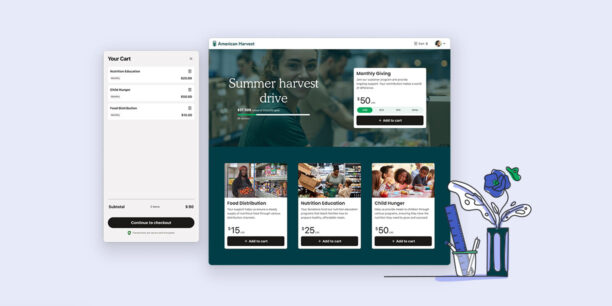Livestream Fundraising: What It Is and How to Do It

Request a Demo
Learn how top nonprofits use Classy to power their fundraising.
By the end of 2020, it’s expected that 82% of internet traffic will come from livestreams. In 2019 alone, people watched 1.1 billion hours of live video.
Livestreaming was gaining popularity before COVID-19, but in light of the global pandemic, it has become an even more useful tool for nonprofits to connect with and grow their audiences by streaming galas, endurance events, or other virtual events. Many livestreaming platforms have also added features that allow viewers to donate directly to nonprofits while watching live content.
In this blog, we’ll introduce you to what it looks like to livestream your fundraising, talk about the different platforms you can use, share examples of nonprofits doing just that, and suggest best practices to nail your next livestream.
Why and How to Livestream Your Fundraising
Livestreaming your fundraising initiatives involves audio and video that is broadcast live over a social media platform with the intention of collecting donations. It’s an innovative new way to share your brand, and many nonprofits are finding it’s also an opportunity to connect with a younger audience. We also see many using it to incorporate an engaging, real-time element to their virtual events, galas, and endurance events.
The trend toward live video expands your reach for potential new supporters, and those supporters can, in turn, create their own livestream fundraising events on your behalf. Generally speaking, livestream fundraising occurs on three different levels of your nonprofit.
Organizational Level
Livestream fundraising at the organizational level means that your nonprofit and staff are the ones doing or hosting the livestreaming. The live video is broadcast over your nonprofit’s social media accounts and can be fully branded as your event.
Livestream fundraising at the organizational level can be a part of your regularly scheduled marketing strategy. For example, your social media coordinator can plan to go live every other Thursday for a “behind-the-scenes” update on what your nonprofit is working on and how donations will be put to use.
This level of livestreaming can also be specific to a larger event. For example, you could livestream a virtual auction, or, once it’s safe to resume in-person gatherings, you could livestream the speakers at your gala to attendees who can’t make the in-person event.
Free Download: The Virtual Events Toolkit
Influencer Level
Livestream fundraising at the influencer level involves partnering with an influencer or notable public figure with a large social media following to do a livestream on your nonprofit’s behalf. While influencers may use material you’ve previously provided them, the live event takes place on their accounts, leveraging their personal brand to connect followers with your mission.
Once possible, influencers can attend and livestream your in-person events to solicit donations from supporters unable to physically be there. During times of social distancing, they can also create their own virtual events on behalf of your nonprofit.
Peer-to-Peer Level
Livestreaming at the peer-to-peer level enhances your campaigns by adding an engaging way for fundraisers to share their fundraising goals with their communities and solicit donations on your behalf. These livestreamers can make donation appeals to their networks over the broadcast while engaging with potential donors in real-time and speaking directly to their audience about why your nonprofit’s mission matters to them.
Platforms for Livestream Fundraising
Many social platforms offer livestreaming options and easy ways to include a donation component. Below, we’ve listed some of the most common, as well as examples of organizations that have used them effectively.
Twitch
Twitch is a livestreaming service where gamers can connect with and watch each other play video games. In February 2020, the platform had over 3.8 million unique broadcasters, and it sees a daily average of more than 15 million active users.
Popular gamers are also able to fundraise for nonprofits through the site. Between 2012 and 2017, Twitch users livestream fundraised over $75 million for nonprofits. In addition, 78% of users report wanting to see more charity in the gaming industry.
Example
Benjamin “DrLupo” Lupo has 3.6 million followers on Twitch and used the platform to complete a 24-hour livestream that raised over $2.3 million for St. Jude Children’s Research Hospital. During another streaming event, he raised an additional $920,000 for the nonprofit in just four hours.
YouTube Live
As of April 2023, there are 2.5 billion monthly active users on YouTube worldwide, with 73% of adults in the United States using the service on a regular basis.
Nonprofits can fundraise through live YouTube events if they meet certain eligibility criteria and are using Google for Nonprofits. Other YouTube users can fundraise on their behalf if they have access to YouTube Giving. Channels with access to this feature must:
- Be located in the United States, United Kingdom, or Canada
- Have at least 40,000 subscribers
- Be part of the YouTube Partner Program
- Not be designated as made for kids
Through YouTube Giving, these users can then select their nonprofit of choice from the site’s list of eligible organizations and then add a donate button to their livestreaming events.
Example
Musical group The Midnight used YouTube Live to hold an online concert that raised money for Plus1’s COVID-19 Relief Fund. During the live event, a donate button was available.
After the event, users could watch the recorded content and find instructions for other ways to donate listed in the event’s description. The live event also included a live chat box where supporters could engage in real-time with one another and the content creators.
Facebook Live
Over 800 million people currently engage with live videos across Facebook every day, and livestreams get the most viewers and engagement when compared to all of the platform’s video options.
When a Facebook user goes live within the Facebook Stories feature, they can select “add donate button” from the left-hand menu on their screen and select their nonprofit of choice. Once livestreaming, a donate button will appear on the screen to viewers and they’ll be able to see how much money has been raised overall. Nonprofits can also raise money through their own livestreams on the platform if they have a verified page on Facebook.
Example
After Hurricane Harvey in 2017, Best Friends Animal Society did a livestream over Facebook at the site of a pop-up shelter they had created in Austin for rescued pets. They interviewed staff who had driven several hours transporting 87 cats and dogs to the site, as well as showed scenes of the rescued pets. The broadcast was just six minutes and 53 seconds in length, but garnered over 1.5 million views, 20,000 shares, and nearly $102,000.
Instagram Live
Instagram Live operates similarly to Facebook Live, but just launched in April 2020 to support more causes during challenging times of crisis.
To access it, users tap the camera icon at the top left-hand side of their feed, then the Live option at the bottom of the screen, and then select Fundraiser. Instagram users can select from over 1 million nonprofits to fundraise for through the live Stories feature.
Users who choose to donate can select an “I Donated” sticker to share within their own stories. Instagram then posts all stories that feature this sticker into a compilation of accounts you follow in an effort to highlight the spirit of giving.
Example
For the new feature’s launch, singer and actress Sofia Carson held a livestream fundraiser on Instagram for UNICEF USA. The livestream was tied to the moment, connecting people during the isolation caused by COVID-19 while raising funds for related work.
6 Best Practices to Livestream Your Fundraising
There are several steps your nonprofit, influencer team, and supporters can take to keep their livestream audiences engaged.
1. Plan and Rehearse for Live Virtual Events
If you’re planning a virtual auction, livestreamed speaker series, or any other larger remote event, rehearse with your team ahead of time to ensure your message is clear and that you’ve worked out potential glitches with the technology. Use a script to communicate with your audience and have a plan for transitions between content and speakers to avoid confusing periods of silence.
2. Incorporate Pre-Recorded Videos
Playing pre-recorded videos in between speakers can help switch up the flow of your event, keeping viewers engaged by using varied content. It can also create smoother transitions that allow your staff time to set up for the next livestream speaker or activity. Finally, incorporating pre-recorded videos into your livestream allows you to share more polished content around your message in addition to the more personal live speaker approach.
3. Encourage Viewer Participation
Encourage viewer participation to keep your audience engaged. In addition to soliciting donations and reminding viewers of the donate button on your livestream, ask them questions that they can answer in the chat box. As viewers donate, give shoutouts in your livestream to specific supporters. Talk personably with the audience like you would a friend rather than talking at the screen like no one is on the other side.
4. Build Momentum Through Other Marketing Channels
Make your livestream an anticipated event by announcing when you’ll be going live through your regular social media posts and other marketing channels. Sharing a fun photo in your Instagram feed with a caption that reads, “Tune in at noon for a live video tour of the newest wing in our animal shelter!” builds momentum for viewers to participate. For larger organized events, you can also offer digital sign-ups that remind supporters through emails and calendar invites of when you’ll be going live.
5. Add Your Livestream to a Campaign Page
The goal proximity effect shows that people are more likely to donate to your cause the closer you are to reaching your goal. They want to be a part of the winning team by helping you get there. Attach your livestream fundraising to a campaign page so viewers can easily track your progress toward meeting your goal and watch the momentum building through other viewers’ support. The social proof of others engaging with your cause can encourage them to take action.
Classy allows your nonprofit to embed YouTube and Twitch livestream broadcasts directly into your campaign page.
6. Equip Influencers and Supporters to Tell Your Story
Both influencer partners and supporters can benefit from access to quick materials from your nonprofit that help tell your story. Provide livestreamers with simple prompts, success stories, photos, and other talking points they can use to share your mission with their audiences while staying true to your brand.
Increase Your Reach and Donations by Livestreaming Your Fundraising
Livestream fundraising offers an engaging, dynamic way to reach larger audiences for donations and support. With many social media platforms now offering in-app donations for livestream events, your nonprofit can leverage both your own accounts and those of influencers to explore creative new fundraisers that can tap into a younger audience.

The Virtual Events Toolkit
Subscribe to the Classy Blog
Get the latest fundraising tips, trends, and ideas in your inbox.
Thank you for subscribing
You signed up for emails from Classy
Request a Demo
Learn how top nonprofits use Classy to power their fundraising.
 Explore Classy.org
Explore Classy.org 

